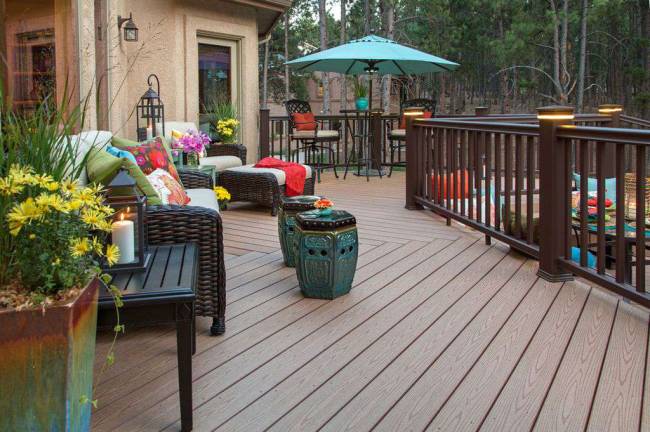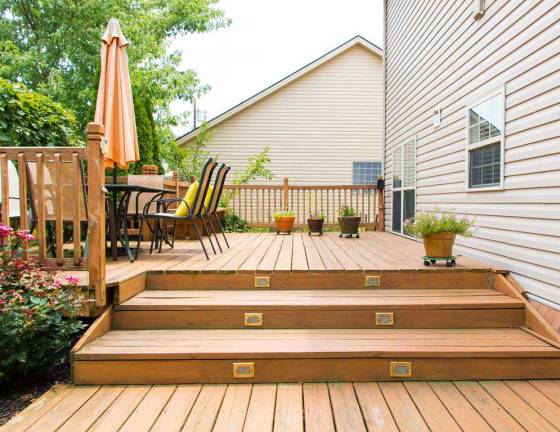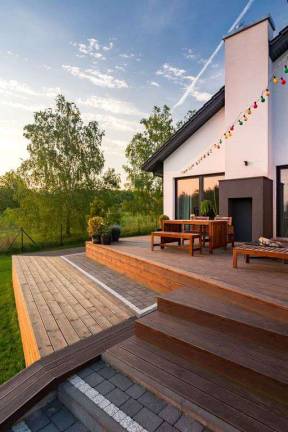Why you need a new or refurbished deck and how to plan for one



It’s more than a home base for your grill and garden hose. It’s beyond an elevated stage for eating and entertaining.
It’s a principal platform for al fresco enjoyment and an extension of your living space into the great outdoors.
And it deserves greater priority, say the pros.
We’re talking about the great American deck, and if you don’t have one yet or are biding your time with one in need of some TLC, what the deck are you waiting for? Spring, after all, is right around the corner.
Jason Davoll, senior product manager at AZEK Building Products, says decks have become an integral part of a typical home’s architecture, expanding your functional square footage and adding a handsome design element to your yard.
Gathering place
“They can be a great gathering place for the family or to entertain guests,” he says. “A deck can often be built at a similar elevation to the living space closest to it, allowing for a seamless flow from indoors to outdoors.”
A properly designed deck creates a more defined gathering area outside your back door, too.
“Most decks are built adjacent to a kitchen, dining area or family room and tend to stay cleaner than a patio or on-grade terrace, eliminating dirt, sand and yard debris that can be tracked into your home,” says Johnson.
Slightly elevated homes — including those with basements — “are ideal for a deck, which can be built on sturdy posts placed deep in the ground and is accessible directly off a sliding patio door,” desirably next to a kitchen or family room, says J.B. Sassano, president of Mr. Handyman. “Compare that to a patio, which has to be built at ground level, where water and moisture can slowly wash away the base that holds the brick or stone pavers up — making for an unsightly, uneven surface.”
A deck that’s an independent structure and set off a bit from your residence can also be desirable.
“This creates a separate space for more privacy or a unique purpose. Perhaps it can provide a great vantage point for some great feature of your property, like a waterfront or skyline,” Davoll notes.
Costs vary
Crafting a new deck doesn’t have to be cost-prohibitive.
Today, a variety of colors, styles, sizes, and finishes are available for a range of budgets, and improvements in materials have led to greater longevity and satisfaction.
“Pressure-treated southern yellow pine is still the most popular decking material because it doesn’t decay like untreated wood and is less costly,” says Bill Hirsch, a Pinehurst, N.C. architect and author of “Designing Your Perfect House” (Dalsimer Press, 2016). “Tropical woods like Ipe and Massaranduba are wonderful decking materials that don’t warp, splinter or decay. Even though they’re quite expensive, they can be a good investment because they last a long time and look great.”
Sassano says other worthy decking choices include redwood and cedar wood, which are naturally insect, decay and fire-resistant but are soft and prone to marring/denting; wood and plastic composite, which retains the look of real wood in an array of hues and doesn’t rot, shrink, splinter or require routine sealing or staining like real woods but which are costly and hot underfoot in summertime; and rubber composite, made with a mix of polyethylene resins and recycled tires to withstand extreme heat and cold.
“Among the popular deck styles today are contemporary, which is sleek, sparse and modern, using basic shapes and clean lines; colonial, a classic symmetrical design that can incorporate planter boxes; traditional, with octagon layouts and chamfered corners; mountain, employing heavy timber framing and rustic rog railings; and coastal, built to stand up to wet seaside conditions,” Sassano adds.
Basic decks still remain mostly rectangular, says Johnson, “while higher-budget decks offer multi-levels and curved sides with custom railings.”
Cable designs
Cable railings are gaining in popularity, since they don’t obstruct your view like wooden or metal railings do, Hirsch says.
“Expect to pay from $50 to $100 a square foot and up for a new deck, depending on the components chosen,” says Robert Heidenreich, president of The Deckstore, who recommends choosing a professional designer/installer and getting the proper municipal permits.
Got an older deck? Consider refurbishing or resurfacing it instead of replacing it.
“This option is best when the deck’s substructure is still in good shape. Make sure all decking connections are sound and that it was built to code.” Davoll says. “If any joists or planks are bowed or higher or lower than the rest of the deck, consider replacing them.”
If that deck is up to spec, think about expanding it or adding some new toys.
“Implement built-in seating benches with lift-up seats that offer additional seating and extra storage,” suggests Rick Johnson, owner of STL Remodeling and General Contracting. “Install low-voltage LED lighting, which provides extra illumination and added safety around stairs.
Consider adding heating towers, outdoor speakers, or an LED TV in a weatherproof enclosure. And think about a hot tub, too.”